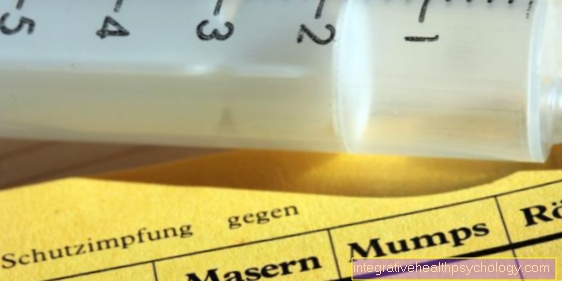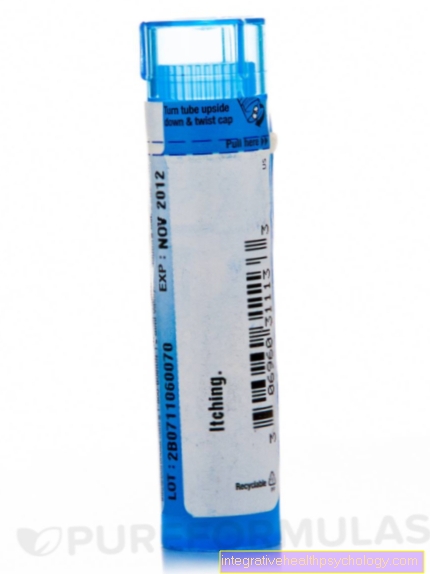Life expectancy with water in the lungs
introduction
In some diseases, pulmonary edema (water in the lungs) occurs and can lead to severe impairment due to shortness of breath. If water retention in the lungs continues, pulmonary edema can also be fatal.
As a rule, the course of the underlying disease is decisive for the further course and life expectancy. For this reason, it is not possible to talk about life expectancy in pulmonary edema without considering the cause or the underlying disease.

What positively influences life expectancy?
In any case, early treatment should be started with the doctor so that the cause can be clarified. Because without a known cause, pulmonary edema is difficult to treat.
If the cause is known, it is advisable to acquire knowledge of the underlying disease. Many underlying diseases can be positively influenced by exercise, weight loss and a healthy diet, such as heart failure, which is a common cause of pulmonary edema. As a rule, an improvement in the underlying disease leads to an improvement in pulmonary edema and life expectancy. You can also speak to a nutritionist for support.
With both heart failure and kidney failure, it is also important to pay attention to the water balance. One should not drink too little or too much so that the water does not build up in the lungs or other tissues. In addition, constant drinking behavior and regular weighing make medication setting easier.
Furthermore, regular check-ups with the doctor, possibly also with the specialist, are important in order to detect any threats in good time.
You may also be interested in this article: Lose weight by changing your diet
What has a negative impact on life expectancy?
Under no circumstances should you smoke if you have pulmonary edema. Smoking worsens the oxygen supply. An acute worsening of the symptoms is possible.
Pneumonia also has a negative impact on life expectancy. Without treatment for the pulmonary edema, pneumonia usually occurs. This can be fatal. Therefore, if pneumonia is suspected, intensive medical treatment should be given immediately.
Mountain hikes should be avoided. At altitude, the partial pressure of oxygen falls, which leads to an intensification of the symptoms due to the poorer oxygen supply. Acute pulmonary edema can also occur in healthy people at high altitudes. Other sporting activities that put a lot of strain on the lungs should also be avoided. Depending on the cause of the pulmonary edema or the underlying disease, there are many other factors that negatively influence the underlying disease and thus also have a negative effect on the pulmonary edema.
Pulmonary edema
With cancer
In lung cancer and lung metastases in particular, pulmonary edema occurs due to water retention.
In the case of advanced cancer, systemic water retention in the entire body can also occur and thus water accumulation in the lungs, a pulmonary edema. Life expectancy with such an advanced cancer disease is poor.
However, there are great individual differences, as the therapies respond depending on the type of cancer and personal constitution and can extend life expectancy.
You might also be interested in this topic: These symptoms help you identify water in your lungs
For breast cancer
Lung edema typically does not occur in breast cancer.
In the advanced stages, breast cancer metastasizes mainly to the lungs and is then usually no longer curable, while in the early stages without metastasis there are still very good chances of a cure. The metastases in the lungs can lead to pulmonary edema. Most of the time it is already a very advanced stage with a severely limited life expectancy.
Also read our topic: Metastasis in breast cancer
For lung cancer
In lung cancer, the lungs are restricted and damaged in many ways. Pulmonary edema occurs in a complex with many other consequences and symptoms.
With lung cancer, too, life expectancy is heavily dependent on how drug growth and symptoms can be influenced. In the initial stages, lung cancer is still curable. However, lung cancer is often detected at a later stage. On average, 10-20% of those with lung cancer are still alive after 5 years.
Further information on this: Lung cancer prognosis
With metastases
The lungs are an organ to which other tumors often metastasize and cause symptoms as they progress. In the case of metastases, the therapy options are unfortunately very limited and the disease is no longer curable.
Medicines can have a positive effect on the progression and symptoms of metastases and extend the life span. How well the lifespan can be extended through therapies varies greatly from person to person. It also depends on what type of metastasis it is.
With cirrhosis of the liver
Liver cirrhosis is a malfunction of the liver. Among other things, protein formation is disturbed, so that there are too few proteins in the blood. This lowers the oncotic pressure of the blood so that the blood no longer draws as much water. The rest of the water remains in the organs, including the lungs.
The extent of pulmonary edema roughly correlates with the severity of liver cirrhosis. Nevertheless, in the case of pulmonary edema due to liver cirrhosis, the stage of liver cirrhosis is decisive for life expectancy. In the first stage, life expectancy is still very good. In the latter stage, over 60% will die over the course of the next year.
You may also be interested in this topic: Protein deficiency edema





























